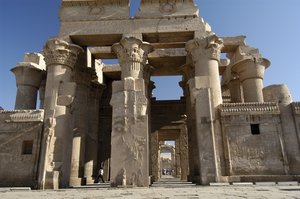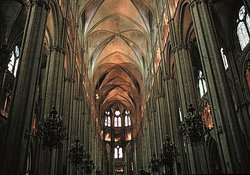Architectural history
|
|
Architectural history studies the evolution and history of architecture across the world through a consideration of various influences- artistic, socio-cultural, political, economic and technological. In general, the question is one of relating meaning (intangible functions, purposes, symbols) with the built environment (material tables, windows, roofs, paths) through the necessities of life (food, work, communion etc.) within the historical context. Architectural history, like any other form of historical knowledge, is subject to the limitations and potentialities of history as a discipline. Consequently there have been a wide range of perspectives in the study of architecture, most of them Western.
In the 19th century, architecture of the past was understood from a formal perspective, emphasizing the morphological characteristics of form, technique and materials. This period also saw the emergence of the individual architect, the amalgamation of whose conscious intentions would become the subject of artistic movements. In these respects, architectural history is a subdiscipline of art history that focuses on the historical evolution of principles and styles in the design of buildings and cities.
Under the pressures of post-modern pluralism, recent theorists have tried to open architecture to a wide variety of new interpretations. New linguistic theories were popular in the mid-1990s and attempted to "read" architectural elements as an autonomous language, contributing to the ongoing Critical Theory project. The work of Hermeneutics constitutes another perspective on architectural history, and centres on the situational nature of architecture as understood phenomenologically. Although both approaches identify architecture as a sort of language, they differ on the terms of reference; Critical Theory is largely self-referential, whilst Hermeneutics is contextual.
The current climate of opportunism can be seen as a reaction to both the metaphysics of the previous theories, as well as the advance into supermodernity manifest in globalisation, late capitalism and neo-liberal democracy. An increasing awareness of colonialism's influence has also encouraged a re-examination of architecture in previously colonised countries and seeks to liberate its history and practice from inappropriate Western doctrines.
The establishment of architectural history as a discipline in the West is reflected in the greater historical clarity of western architectural development, whilst the understanding of non-western architecture often proceeds with less historical context. Matters are further complicated by incidences of Western colonialism. Postmodern historical narratives attempt to address such issues but the scope of the subject matter denies consensus among historians, even individual historians have changed approaches across time — the changing frameworks traced across the many editions of Sir Banister Fletcher's popular book is a case in point. But in general, it can be said that Architectural history reflects the historical development of its time.
| Contents |
Prehistoric architecture
Ancient architecture
At the beginning, humanity was confronted with a world thoroughly alive with gods, demons and spirits, a world that knew nothing of scientific objectivism. The ways in which the people came to terms with their immediate environment were thus grounded in the omnipotence of Gods. Many aspects of daily life were carried out with respect to the idea of the divine or supernatural and the way it was manifest in the mortal cycles of generations, years, seasons, days and nights. Harvests for example were seen as the benevolence of fertility deities. Thus, the founding and ordering of the city and her most important buildings (the palace or temple) were often executed by priests or even the ruler himself and the construction was accompanied by rituals intended to enter human activity into continued divine benediction. Ancient architecture is characterised by this tension between the divine and mortal world. Cities would mark a contained sacred space over the wilderness of nature outside, and the temple or palace continued this order by acting as a house for the Gods. The architect, be he priest or king, was not the sole important figure; he was merely part of a continuing tradition.
- Ancient Egyptian architecture
- Assyrian architecture
- Babylonian architecture
- Etruscan architecture
- Minoan architecture
- Mycenaean architecture
- Persian architecture
- Sumerian architecture
Western Architecture — Classical to Eclecticism
Classical architecture
Reconstructed.agora.athens.1.jpg
Ancient.rome.forum.1.jpg
The architecture and urbanism of the Greeks and Romans were very different from those of the Egyptians or Persians in that civic life gained importance. During the time of the ancients, religious matters were the preserve of the ruling order alone; by the time of the Greeks, religious mystery had skipped the confines of the temple-palace compounds and was the subject of the people or polis. Greek civic life was sustained by new, open spaces called the agora which were surrounded by public buildings, stores and temples. The agora embodied the new found respect for social justice received through open debate rather than imperial mandate. Though divine wisdom still presided over human affairs, the living rituals of ancient civilizations had become inscribed in space, in the paths that wound towards the acropolis for example. Each place had its own nature, set within a world refracted through myth, thus temples were sited atop mountains all the better to touch the heavens.
The Romans conquered the Greek cities in Italy around three hundred years before Christ and much of the Western world after that. The Roman problem of rulership involved the unity of disparity — from Spanish to Greek, Macedonian to Carthaginian — Roman rule had extended itself across the breadth of the known world and the myriad pacified cultures forming this ecumene presented a new challenge for justice. One way to look at the unity of Roman architecture is through a new-found realisation of theory derived from practice, and embodied spatially. Civically we find this happening in the Roman forum (sibling of the Greek agora), where public participation is increasingly removed from the concrete performance of rituals and represented in the decor of the architecture. Thus we finally see the beginnings of the contemporary public square in the Forum Iulium, begun by Julius Caesar, where the buildings present themselves through their facades as representations within the space. As the Romans chose representations of sanctity over actual sacred spaces to participate in society, so the communicative nature of space was opened to human manipulation. None of which would have been possible without the advances of Roman engineering and construction or the newly found marble quarries which were the spoils of war; inventions like the arch and concrete gave a whole new form to Roman architecture, fluidly enclosing space in taut domes and colonnades, clothing the grounds for imperial rulership and civic order.
This was also a response to the changing social climate which demanded new buildings of increasing complexity — the coliseum, the residential block, bigger hospitals and academies. General civil construction such as roads and bridges began to be built.
Medieval architecture
The liberation of representation from reality advanced the cause of Roman cohesion. We left the Romans in the Forum Illium, where we saw the beginnings of general space, free, to an extent, of the spiritual and religious values that made up the space of all previous civilisations. The ramifications of this can be seen in the speculative architectures of Nero and Hadrian where architecture represents increasingly abstract concepts of time, history and rulership. But it was Christianity that first established a universal concept over the Roman world — a single God as exclusive source — thus supplanting concrete imperial duty with intangible faith. The conscious power over representation was allied with a new faith in a universal God borne out in architectures structured towards light, as a representation of divinity, through geometry.
Italian Renaissance architecture
Cortile.del.belvedere.1.jpg
The Renaissance often refers to the Italian Renaissance that began in the 15th century, but recent research has revealed the existence of similar movements around Europe before the 15th century; consequently, the term "Early Modern" has gained popularity in describing this cultural movement. This period of cultural rebirth is often credited with the restoration of scholarship in the Classical Antiquities and the absorption of new scientific and philosophical knowledge that fed the arts.
The development from Medieval architecture concerned the way geometry mediated between the intangibility of light and the tangibility of the material as a way of relating divine creation to mortal existence. This relationship was changed in some measure by the invention of Perspective which brought a sense of infinity into the realm of human comprehension through the new representations of the horizon, evidenced in the expanses of space opened up in Renaissance painting, and helped shape new humanist thought.
Perspective represented a new understanding of space as a universal, a priori fact, understood and controllable through human reason. Renaissance buildings therefore show a different sense of conceptual clarity, where spaces were designed to be understood in their entirety from a specific fixed viewpoint. The power of Perspective to universally represent reality was not limited to describing experiences, but also allowed it to anticipate experience itself by projecting the image back into reality.
Donato Bramante's Cortile del Belvedere project is one such instance where spaces were pictured/designed together before being built. Such a space was only possible due to the powers of abstraction, offered by perspective, that allowed the composition of heterogenous activities into a metaphor for the legitimacy of current rule. The commission was set by Pope Julius II to connect an ancient pontifical palace on the right of St Peter's with the palace, built by Pollaiolo for Innocent VIII. In doing so Bramante organised the ascent through three courts that sees the lower, theatrical level move into the upper level through increasingly planned gardens thereby creating a tension between the human realm and an idealised vision of the "ideal city", Jerusalum, this is explicitly shown in Bramante's depiction of the ascent from the perspective of Pope Julius's bedroom window.
Baroque architecture
If Renaissance architecture announced a rebirth of human culture, the periods of Mannerism and the Baroque that followed signalled an increasing anxiety over meaning and representation. Important developments in science and philosophy had separated mathematical representations of reality from the rest of culture, fundamentally changing the way humans related to their world through architecture.
The Age of Enlightenment
Rationality and the universals lead to the emancipation of history, Gottfried Semper leads the fray, filleting of "beauty" leads to contemporary notions of form, the seed of Modernity.



